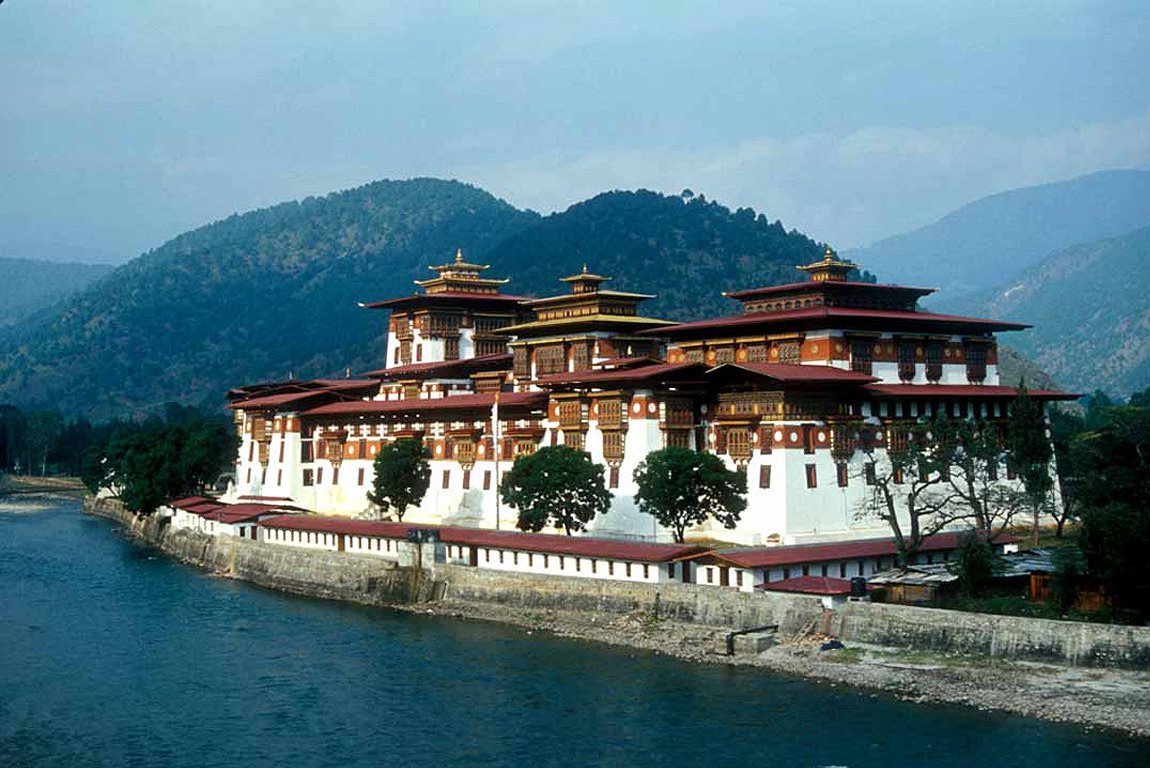Punakha Tsechu Festival Tour combines the popular Punakha Tsechu Festival with visits to important attractions of Punakha, Paro and Thimpu. The Punakaha Tsechu Festival offers a rare glimpse into the traditional Bhutanese culture and faith. The festival is held every year during February at Punakha Dzong to offer honor to Guru Padmashambhava. It features mask dances by monks accompanied by Bhutanese traditional instruments, reading of religious scripts and chants and the unfolding of sacred scroll depicting Padmashambhava.
While the locals attend the colorful festival to acquire merit, visitors travel from far and near to witness the spectacular display of color, aged old traditions, and tantric Buddhist rituals. The event inside Paro Rinpung Dzong initiates with monks performing the Shingje Yab Yum – the dance of the lord of death (Shingje) and his companion. This is followed by Durdag – the dance of the lords of the cremation grounds, after which, the dance of the black hats, Shanag, and the dance of the drums from Drametse (Drametse Ngacham) are performed.
The second part of the tour will engage you in visiting sacred Buddhist monasteries and ancient fortresses such as Punakha Dzong, Taktsang Monasery etc. and exploring Phobjikha Valley, Thimphu and Paro. .
Itinerary
Day 1
Kathmandu - Paro
Fly from Kathmandu to Paro on a Druk Air flight which offers the most fascinating aerial views of the Himalayas including Everest and Kanchendzonga. At first glimpse, the Bhutanese landscape will mesmerize you with its green rolling mountains, river valleys, waterfalls and the great snowcapped Himalayan peaks.
The flight takes about 1 hour to arrive at Paro Airport. Check in at the hotel.
In the afternoon, go sightseeing in and around Paro. Our first stop is the Taktsang monastery or Tiger’s nest. The climb up to the top of the Monastery will take around three hours. It was here that Guru Padmasambava landed on the back of a tiger in the 8th century, and mediated for three months. The monastery took its present modern shape in 1684. Overnight in a hotel in Paro.
Day 2
Paro sightseeing
This day is set aside for Paro Sightseeing.
We will spend the whole day today visiting some of the important landmarks of Paro. we will visit the old fort ruins of the Drukgyal Dzong. The dzong was destroyed by fire and left in ruins as an evocative reminder of the great victories it was built to commemorate. On a clear day you could see the Mt. Jhomolhari (7314metres/24000 feet) on the horizon.
Built in 1656, Ta Dzong is an ancient watchtower, which now houses the National Museum. This unusual round building is believed to be in the shape of a conch shell. Paro Rimpung Dzong, literally meaning “Heap of Jewels”, was built in 1646 by Shabdrung Ngawang Namgyal, and represents the finest example of Bhutanese architecture.
Our final tour takes us to Kichu Lhakhang which was built in 659 A.D by the Tibetan king Srongsen Gampo. This Monastery is one of the 108 monasteries built across the Himalayan region by the Tibetan King to subdue the Demons living the Himalayan region. The rest of the monasteries lie in other neighboring countries.
Overnight in Paro.
Day 3
Paro to Punakha
Morning drive over the Dochu-La pass (3,100 meters), which on a clear day offers an incredible view of Himalayan peaks including Mt. Chomlohari (7134m) or the Mountain of Gods.
Punakha was the ancient capital of Bhutan. Punakha Dzong, isthe residence of Je Khenpo or the Chief Abbot of Bhutan. The Dzong is situated in the middle of two rivers (Pho chu and Mo chu).
Overnight in Punakha.
Day 4
Attend Punakha Tsechu Festival
The Punakaha Tsechu Festival offers a rare glimpse into the traditional Bhutanese culture and faith. The festival is held every year during February to offer honor to Guru Padmashambhava at Punakha Dzong. It features mask dances by monks accompanied by Bhutanese traditional instruments, reading of religious scripts and chants and the unfolding of sacred scroll depicting Padmashambhava
Day 5
Punakha to Phobjikha Valley
Early morning drive from Punakha to Phobjikha Valley which takes about 3 hours. Drive up a winding mountain road through oak and rhododendron forests, and over a high pass down into the picturesque Phobjikha Valley. Phobjikha is famous for glaciers and also for rare birds like black necked cranes.
Overnight in a hotel in Phobjikha.
Day 6
Phobjikha Valley to Thimphu
Early morning drive back to Thimphu which takes about 6 hours.
Overnight in Thimphu.
Day 7
Thimpu Sightseeing
After early breakfast, we will visit the National Library to see ancient Buddhist manuscripts and traditional art school. The Traditional Medicine Institute showcases ancient Bhutanese practices of making medicine.
We will further visit Handicraft Emporium, an art and textile center, Bhutanese traditional paper making factory, the Memorial chorten built in the memory of the late King Jigme Dorji Wangchuck and 15th century Changangkha monastery.
After lunch, we will visit National Memorial Chorten built by Queen mother in memory of Lt. King Jigme Dorji Wangchuck. Overnight in a hotel in Thimphu.
Day 8
Thimphu to Paro
Early morning drive to Paro. We will spend the rest of the day visiting some of the important landmarks of Paro. We will tour Ta Dzong, which houses the National Museum, the ruins of Drugyel Dzong and the courtyard of 7th century Kichu Lhakhang. Kichu Lhakhang was built by Tibetan King Trsongsan Gampo, and is one of the 108 chortens he built all across the Himalayas to suppress the influence of demons. Overnight in a hotel in Paro.
Day 9
Paro to Kathmandu
You will take morning flight to Kathmandu from Paro Airport.
 Make an inquiry
Make an inquiry